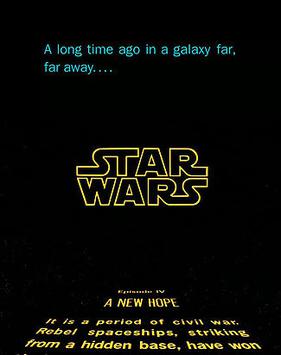
Star Wars is an American epic space opera media franchise created by George Lucas, which began with the eponymous 1977 film and quickly became a worldwide pop culture phenomenon. The franchise has been expanded into various films and other media, including television series, video games, novels, comic books, theme park attractions, and themed areas, comprising an all-encompassing fictional universe. Star Wars is one of the highest-grossing media franchises of all time.

Return of the Jedi is a 1983 American epic space opera film that is the sequel to Star Wars (1977) and The Empire Strikes Back (1980). It is the third installment in the original Star Wars trilogy and the sixth chronological film in the "Skywalker Saga". It is directed by Richard Marquand based on a screenplay by Lawrence Kasdan and George Lucas from a story by Lucas, who was also the executive producer. The film follows the ongoing struggle between the malevolent Galactic Empire and the freedom fighters of the Rebel Alliance. As the Rebels attempt to destroy the Empire's second Death Star, Luke Skywalker hopes to bring his father, Darth Vader, back from the dark side of the Force. The film stars Mark Hamill, Harrison Ford, Carrie Fisher, Billy Dee Williams, Anthony Daniels, David Prowse, Kenny Baker, Peter Mayhew and Frank Oz.
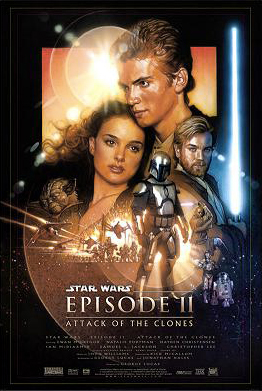
Star Wars: Episode II – Attack of the Clones is a 2002 American epic space opera film directed by George Lucas and written by Lucas and Jonathan Hales. The sequel to The Phantom Menace (1999), it is the fifth film in the Star Wars film series and second chronological chapter of the "Skywalker Saga". The film stars Ewan McGregor, Natalie Portman, Hayden Christensen, Ian McDiarmid, Samuel L. Jackson, Christopher Lee, Anthony Daniels, Kenny Baker, and Frank Oz.
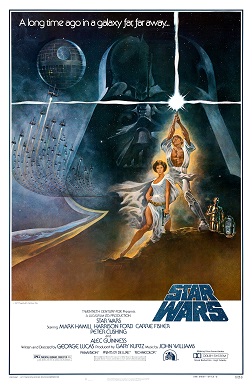
Star Wars is a 1977 American epic space opera film written and directed by George Lucas, produced by Lucasfilm and distributed by Twentieth Century-Fox. It was the first film released in the Star Wars film series and the fourth chronological chapter of the "Skywalker Saga". Set "a long time ago" in a fictional galaxy ruled by the tyrannical Galactic Empire, the story follows a group of freedom fighters known as the Rebel Alliance, who aim to destroy the Empire's newest weapon, the Death Star. When the Rebel leader Princess Leia is abducted by the Empire, Luke Skywalker acquires stolen architectural plans of the Death Star and sets out to rescue her while learning the ways of a metaphysical power known as "the Force" from the Jedi Master Obi-Wan Kenobi. The cast includes Mark Hamill, Harrison Ford, Carrie Fisher, Peter Cushing, Alec Guinness, Anthony Daniels, Kenny Baker, Peter Mayhew, David Prowse, and James Earl Jones.
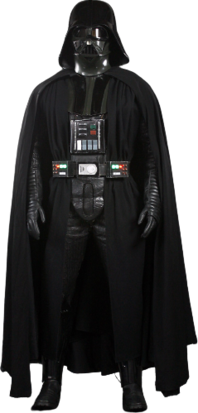
Darth Vader is a character in the Star Wars franchise. He is the primary antagonist of the original film trilogy and, as Anakin Skywalker, is the protagonist of the prequel trilogy. Born a slave, he later becomes a powerful Jedi. He is lured to the dark side of the Force by Chancellor Palpatine, and becomes the Sith Lord Darth Vader. After being severely wounded in a lightsaber battle, he is transformed into a cyborg. He is the husband of Padmé Amidala and the biological father of Luke Skywalker and Leia Organa Solo.
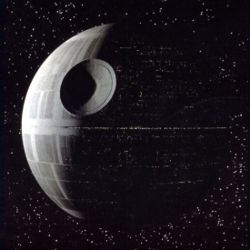
The Death Star is a fictional space station and superweapon featured in the Star Wars space-opera franchise. Constructed by the autocratic Galactic Empire, the Death Star is capable of obliterating entire planets, and serves to enforce the Empire's reign of terror. Appearing in the original 1977 film Star Wars, the Death Star serves as the central plot point and setting for the movie, and is destroyed in an assault by the Rebel Alliance during the climax of the film, with the 2016 prequel film Rogue One and the 2022 television series Andor exploring its construction. A larger second Death Star is being built in the events of the 1983 film Return of the Jedi, featuring substantially improved capabilities compared to its predecessor, before it is destroyed by the Rebel Alliance while under construction.

Star Wars: Episode III – Revenge of the Sith is a 2005 American epic space opera film that is the sequel to The Phantom Menace (1999) and Attack of the Clones (2002). It is the sixth film in the Star Wars film series, the third installment in the Star Wars prequel trilogy, and third chronological chapter of the "Skywalker Saga". It is written and directed by George Lucas, who also served as executive producer. The film stars Ewan McGregor, Natalie Portman, Hayden Christensen, Ian McDiarmid, Samuel L. Jackson, Christopher Lee, Anthony Daniels, Kenny Baker, and Frank Oz.

The Clone Wars is a fictional conflict in the Star Wars franchise by George Lucas. Though mentioned briefly in the first Star Wars film, the war itself was not depicted until Attack of the Clones (2002) and Revenge of the Sith (2005). The Clone Wars are also the setting for three eponymous projects: a 2D animated series (2003–2005), a 3D film (2008), and a 3D animated series. They have featured in numerous Star Wars books and games.
Susan "Suzy" Elizabeth Rice is a screenwriter, author of fiction, painter and designer. Rice is noted as the designer of the logo for the series of Star Wars films, as well as many other film logo designs for print advertising and some filmed applications.

Many of the films in the Star Wars franchise have been re-released, both theatrically and on home media formats. Franchise creator George Lucas often altered the films for the re-releases. These alterations range from minor refinements to major changes. The original trilogy was altered the most, although revisions were also made to the prequels. According to Lucas, some changes brought the films closer to his original vision, while others were attempts to create continuity with later films.
The original Star Wars trilogy, formerly marketed as the Star Wars Trilogy, is the first set of three films produced in the Star Wars franchise, an American space opera created by George Lucas. It was produced by Lucasfilm and distributed by 20th Century Fox, and consists of Star Wars (1977), The Empire Strikes Back (1980) and Return of the Jedi (1983). Beginning in medias res, the original trilogy serves as the second act of the nine-episode Skywalker Saga. It was followed by a prequel trilogy between 1999 and 2005, and a sequel trilogy between 2015 and 2019. Collectively, they are referred to as the "Skywalker Saga" to distinguish them from spin-off films set within the same universe.

Over one hundred video games based on the Star Wars franchise have been released, dating back to some of the earliest home consoles. Some are based directly on films while others rely heavily on the Star Wars Expanded Universe.

The Art of Star Wars is a series of books by various editors featuring concept art from the Star Wars motion picture saga. The books mainly feature artwork accompanied by a short explanation of the scene and the artist's ideas, but also script notes, posters and other information. The first books were published by Ballantine Books, a subsidiary of Random House, with later editions appearing under the DelRey and LucasBooks imprints. Later titles were published by Harry N. Abrams.

Star Wars: The Clone Wars is an American animated television series created by George Lucas. It is part of the Star Wars multimedia franchise, and is set predominantly between the events of Star Wars: Episode II – Attack of the Clones (2002) and Star Wars: Episode III – Revenge of the Sith (2005). Lucas, who closely collaborated with supervising director Dave Filoni on the series, called it a continuation of the previous Genndy Tartakovsky-produced 2003 Clone Wars series. The series began with a theatrical feature film that was released on August 15, 2008, and debuted on Cartoon Network two months later on October 3, 2008.
Star Wars has been expanded to media other than the original films. This spin-off material is licensed and moderated by Lucasfilm, though during his involvement with the franchise Star Wars creator George Lucas reserved the right to both draw from and contradict it in his own works. Such derivative works have been produced concurrently with, between, and after the original, prequel, and sequel trilogies, as well as the spin-off films and television series. Commonly explored Star Wars media include books, comic books, and video games, though other forms such as audio dramas have also been produced.
Daniel Richard Perri is an American film and television title sequence designer. He has worked in film title design since the 1970s, and has been responsible for the main titles of a number of notable films including The Exorcist (1973), Taxi Driver (1976), Star Wars (1977), Raging Bull (1980), Airplane! (1980), and Suspiria (2018).
